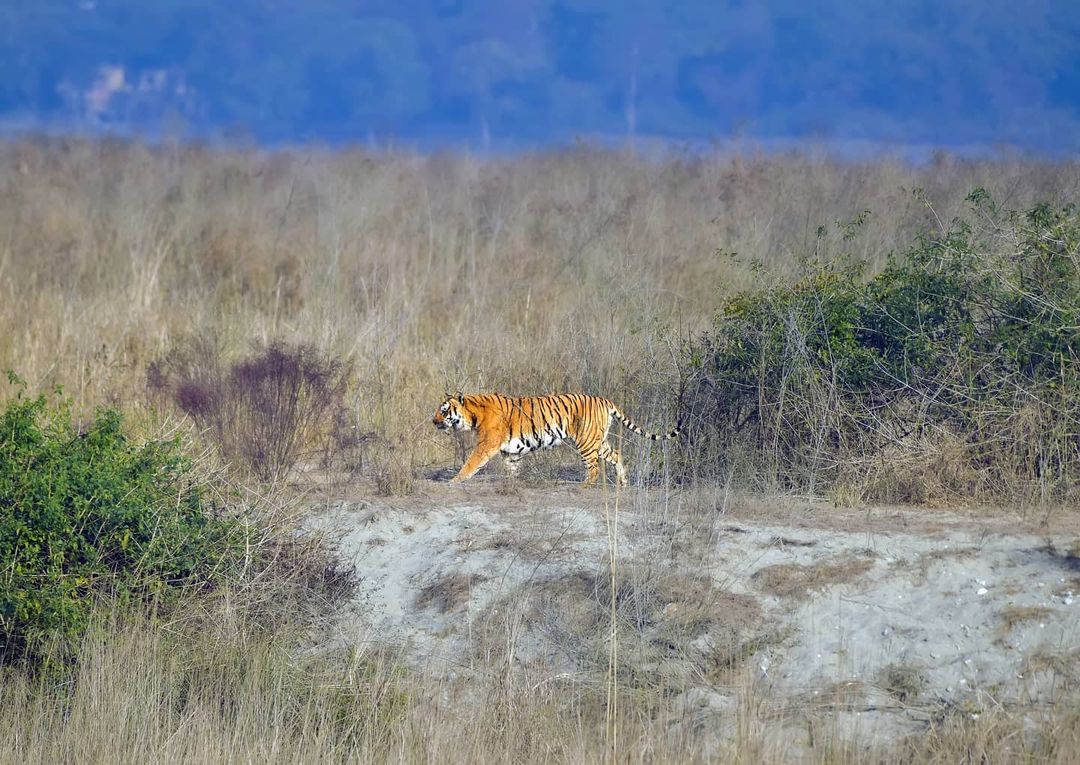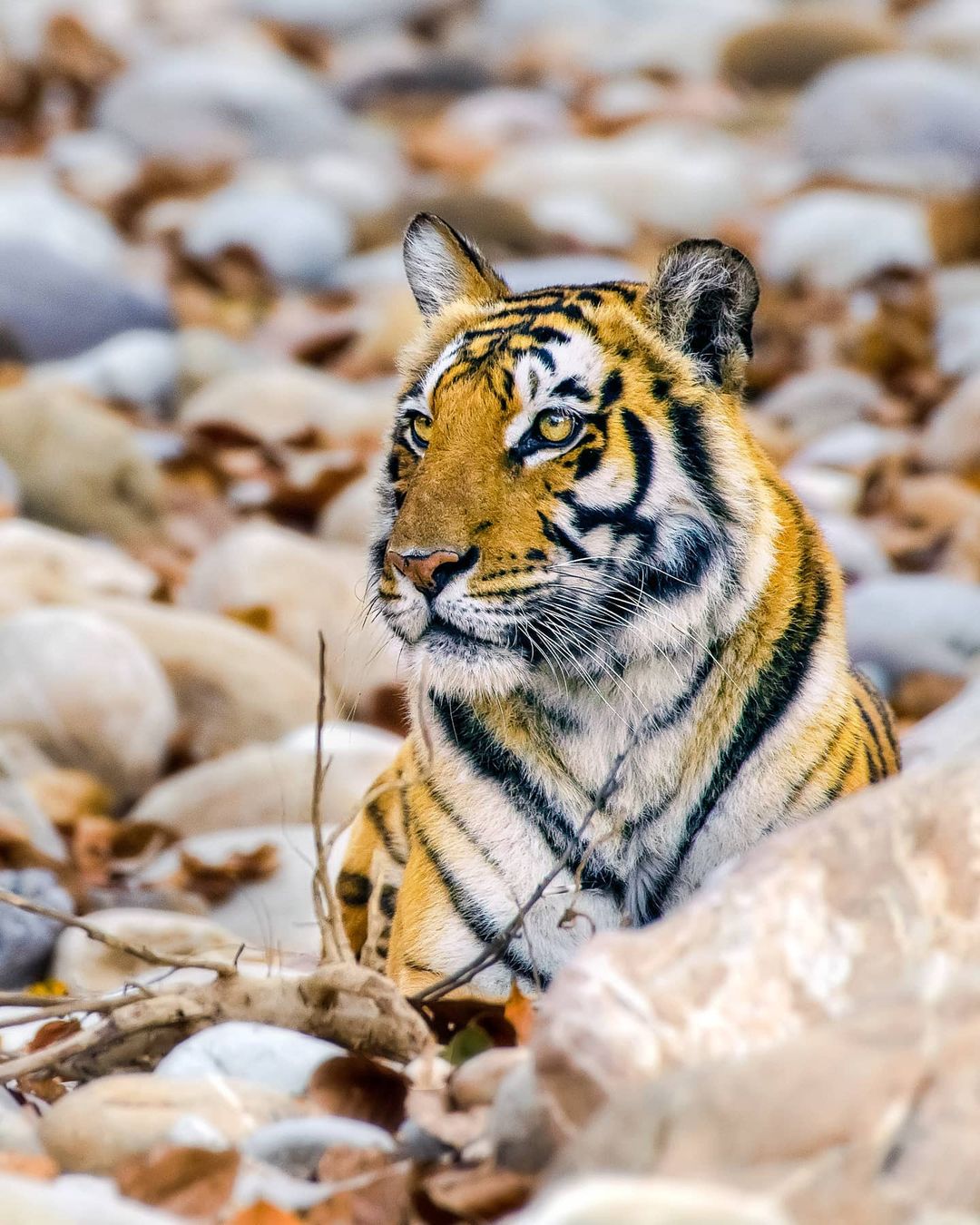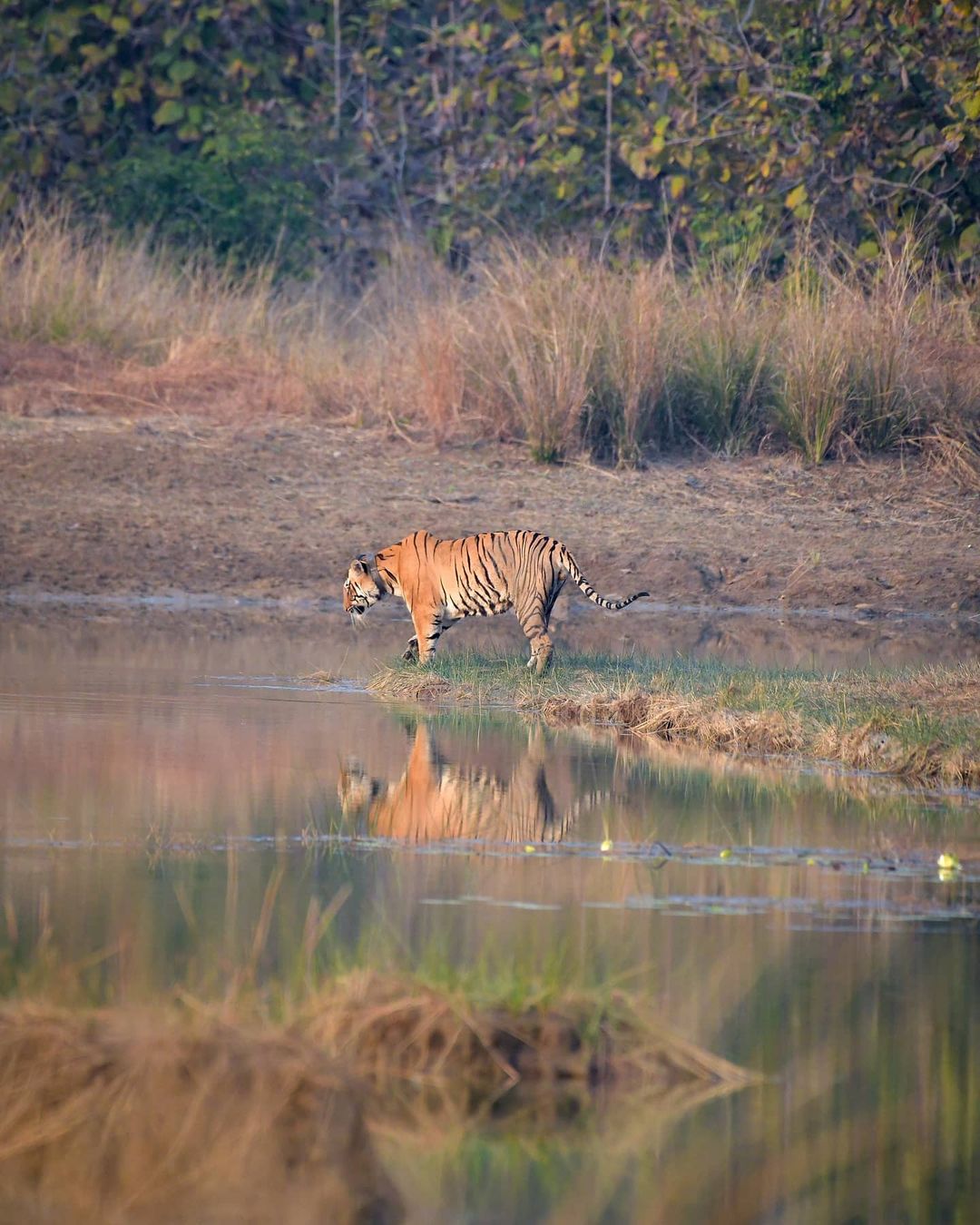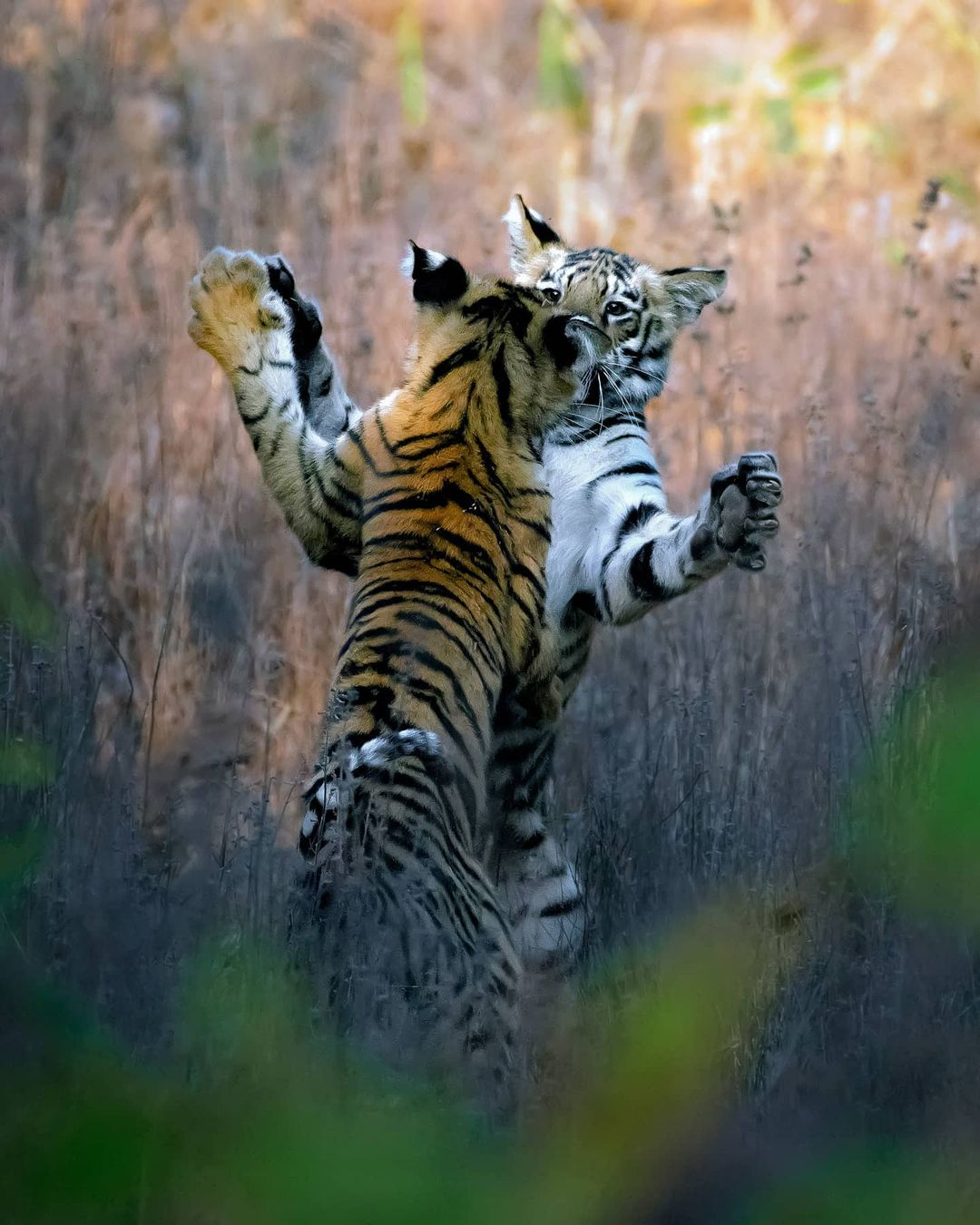

 Photograph © Nihad Vajid
Photograph © Nihad Vajid
I started looking at tigers on Instagram after a naturalist, who had previously enjoyed posting his own big cat images online, complained to me that these posts all start to look the same after a while. He got bored taking cat pictures and restless around people who went on safari expressly to hunt down images. Their end results, the naturalist felt, always ended up looking like copies of tiger photos already posted on social media. Curious to know if his observations would resonate with my own experience on the platform, I typed “tigers India” into Instagram’s search function. Its top three suggestions related to tourism: “India tiger tours,” “India adventure tigers,” and “Indian tour tigers.” Bizarrely, “Indian tigers cocoa” appeared 4th in the list, while I would have to scroll to 6th place to find “Indian tigers Bengal” and to 7th spot for “Indian tigers extinction.” The algorithm was keener to direct me towards opportunities for tourism over information about conservation. Nevertheless, it brought both domains into a joint list of search results. The idea that seeing animals and saving wildlife are related is not limited to Instagram. In Kenya, there is a minister with a dual portfolio of tourism and wildlife.
Initially, looking at tigers on Instagram felt harmless. If I felt guilty, that would have been from spending too long on my phone. Surely, seeing a brilliantly composed photograph of a charismatic animal was an innocent way of passing the time. It felt very different to looking at “trophy shots” of tigers, from the colonial period and immediately after Independence, that vivified dead tigers, lionized the hunter, and rendered civilization’s victory over nature’s cruel designs as a moral good, an experience that had made me feel ill at ease with my own species. The problematic human presence appeared to be absent, at least in direct visual terms, from Instagram’s presentation of remaining vestiges of wilderness hosting tiger habitats. Even if something was amiss, images from “the wild” replacing perverse scenes with dead animals depicted in colonial and mid-twentieth-century tiger photography seemed to represent improvement.
 Photograph © Nihad Vajid
Photograph © Nihad Vajid
After viewing hundreds of images using Instagram’s tag-search (#tigersofindia #bigcatsindia #bengaltiger), it became apparent that photos posted by wildlife enthusiasts on the platform are interchangeable with ones published by commercial entities marketing tiger safaris. After very little time scrolling, I also start to see patterns that my friend the naturalist had already noticed on Instagram: tigers drink from a water body or cool off in a river; another gazes directly at the camera, face artfully sunlit; cubs playfully paw at each other; adults, raised on hind legs, in a spat over territory. But it still looks like progress. Signs of tourism and implied meaning around conservation are plentiful, replacing much earlier celebrations of hunting prowess. Meanwhile images of poaching are rarities. My effort to find the steel jaws of traps used by poachers on the hunt for tigers yielded nothing much until, on World Wildlife Day, I found a Times of India post about a tiger killed by poachers with razor wires intended for wild boar, deer, and blue bulls or nilgai. In reality, on average, ten tigers are lost to poaching every month in India. Returning to the platform’s first result for the “tigers India” search query leads me to a safari tour’s website. Here, I’m told that there is a “100% record to date of seeing Tigers on this tour!” This sounds dubious until I click further into the giddy line-up of safari and photo tour websites and realize that they are probably right. I find my explanation for the 100 percent return on investment on a site selling the contradiction of an experience in nature and the unnatural behavior of its biggest drawing animals: “Tigers are now so used to the presence of people that they seem unconcerned by their close proximity.” Another company, describing two tigresses, named P1 and P2 who frequent Tadoba-Andhari Tiger Reserve, says that they are “totally at ease with vehicles and were never in any hurry to disappear deep into the woodland.”
 Photograph © Ratanjot Singh
Photograph © Ratanjot Singh
 Photograph © Sagar Paranjape
Photograph © Sagar Paranjape
National parks and tiger reserves in India have substantial infrastructure and personnel to ensure tigers are conserved and accessible for viewing by tourists keen to photograph and post their pictures online. Take artificial drinking spots – they satisfy one of the tiger’s basic needs but they also are a source of guaranteed sightings, photo-ops, and future social media posts, the touted “100%” rate of return from earlier. Framing in much of tiger photography on display – including images of tigers drinking from say a river or lake –excludes overhead powerlines and other evidence of manmade infrastructure. Shooting with video would admit many more “unnatural” elements, which would account for a scarcity of video in the accounts that I visited. Other tourists, people holding cameras attached with extra-long lenses, guides, photo-mentors, luxury lodges, and Maruti Gypsey jeeps, mainstays of the national park setting, only very occasionally appeared in the accounts explored. In the space of the photograph, the online enthusiast substitutes an intensely commercialized environment with an intact animal world. The commodity value of these images becomes apparent every time a tour operator appropriates the safari-goers content on their own social media for marketing purposes.
Tigers are crepuscular animals, and sightings in non-human controlled landscapes are rare. Instantly available images online, though, and artificially orchestrated opportunities for tiger sightings in national parks produce an on-demand tourist gaze. Recursive algorithms are suited to reproducing commercially advantageous ways of seeing, and so it’s not surprising that my Instagram search results – repetitive, close-range images of tigers in peopleless national parks – conform to the tourist gaze. In real-world safari settings, the persistence of the human presence poses challenges for manufacturing “wilderness” into a consumer product. Where the tourism sector struggles, the platform excels. Visitors who get stuck in national park traffic jams and ticket queues can recuperate the bad experience by posting images of tigers in pristine landscapes. On social media, seemingly authentic experiences in the wild signal a form of personal achievement tied to worthwhile consumption and access to high-end tourism. Congratulatory comments – “Great picture!” “Superb take!” “Beautiful capture!” – and emoticons accompanying posts are endorsements of the photographer’s social capital and the consumer value compacted in the photograph.
 Photograph © Nihad Vajid
Photograph © Nihad Vajid
 Photograph © Nihad Vajid
Photograph © Nihad Vajid
Novelist and conservationist Wallace Stegner believed that wilderness would have to disappear before technology would have free reign to colonize human attention. Where there is wilderness, it is suggested, there is refuge from technology. In 1960, in his famous “Wilderness Letter,” Stegner points out that, “‘Without any remaining wilderness we are committed wholly, without chance for even momentary reflection and rest, to a headlong drive into our technological termite-life, the Brave New World of a completely man-controlled environment.” The digitally integrated character of living in the contemporary moment makes Stegner’s separation of the natural world from technology difficult to practice or even envision. Instagram and Facebook are often the inciting incidents for venturing into so-called wild places, in the first instance. On safari holiday, far from losing oneself in nature, one locates oneself with images taken for an online audience of friends, family, and followers. “I came back with well in excess of a thousand sharp and ‘in focus’ photographs of tigers,” a tour-organizer’s description of the experience at Tadoba National Park in Maharashtra, offers a measure of the compulsion to visually capture experiences in nature. For all the photos of tigers on the platform, information about the species or its conservation is relatively scarce; on Instagram, and other social media platforms, tiger images are more likely to be instrumentalized for the purposes of communicating to online friends, followers, and customers that experiences in nature are productive avenues for consumer spending. The tour operator, the optimized self on Instagram – a holidaymaker, wildlife enthusiast and content producer – and the platform itself are all dialed into the commodity-value of photographs of nature in an online marketplace of worthwhile experiences. According to the last census, there are an estimated 2967 tigers in India. On Instagram, tiger numbers continue to rise daily.
Copyright © 2021, PhotoSouthAsia. All Rights Reserved.
 Copyright © Aileen Blaney
Copyright © Aileen Blaney
Aileen Blaney is a writer and educator. She teaches film studies at Flame University, Pune. She is co-editor of Photography in India: from Archives to Contemporary Practice (Bloomsbury 2018 / Routledge 2020).
20 November